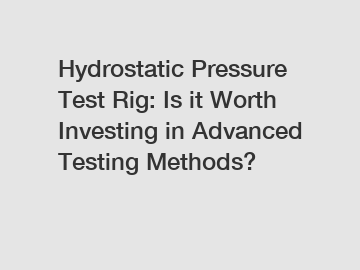Hydrostatic Pressure Test Rig: Is it Worth Investing in Advanced Testing Methods?
Hydrostatic Pressure Test Rig: Is it Worth Investing in Advanced Testing Methods?
In the field of engineering, testing is an integral part of the development and manufacturing process. It ensures that products meet required safety standards and perform optimally under various conditions. One of the crucial aspects of testing is hydrostatic pressure testing, which involves subjecting a component or equipment to high-pressure liquids to assess its durability and detect any potential leaks. While conventional testing methods have served the industry well, there is an ongoing debate about whether it is worth investing in advanced testing methods such as hydrostatic pressure test rigs. In this article, we will explore the benefits and drawbacks of investing in such advanced testing methods and determine their worthiness.
Point 1: Accuracy and Reliability.

One of the primary advantages of utilizing advanced testing methods like hydrostatic pressure test rigs is the increased accuracy and reliability they offer. Unlike conventional testing methods, these high-tech rigs can precisely control the pressure exerted on the specimen, ensuring consistent and repeatable results. This accuracy allows engineers to identify even the slightest defects or weaknesses in the tested components, promoting better quality control.
Point 2: Time and Cost Efficiency.
In the fast-paced world of engineering and manufacturing, minimizing time and cost is of utmost importance. Advanced testing methods, such as hydrostatic pressure test rigs, can significantly contribute to achieving these goals. These rigs are designed to streamline and automate the testing process, reducing the need for multiple manual interventions. They enable engineers to perform tests swiftly and efficiently, ultimately saving valuable time and reducing costs associated with labor and resources.
Point 3: Enhanced Safety.
Safety is a paramount concern in many industries, particularly those dealing with pressurized systems. Hydrostatic pressure test rigs offer advanced safety features that minimize the risks associated with high-pressure testing. These rigs are equipped with state-of-the-art sensors and monitoring systems that ensure the test conditions remain within safe limits. Consequently, the likelihood of accidents or injuries occurring during testing procedures is significantly reduced, safeguarding both workers and equipment.
Point 4: Technological Advancements.
As technology advances, it is essential for industries to keep up with the latest developments to stay competitive. Investing in advanced testing methods like hydrostatic pressure test rigs showcases a commitment to innovation and progress. These rigs incorporate cutting-edge technology, enabling engineers to take advantage of advanced data analysis, visualization, and reporting tools. With these capabilities, engineers can gain deeper insights into the tested components' behavior, paving the way for improved designs and enhanced product performance.
Point 5: Initial Investment and Maintenance.
While the benefits of advanced testing methods are evident, there is a cost associated with acquiring and maintaining these sophisticated test rigs. The initial investment required can be significant, deterring some companies from pursuing this option. Additionally, the maintenance and calibrations costs of such rigs should be factored into the decision. It is important to assess whether the long-term benefits outweigh the initial expenses and ongoing maintenance costs.
Conclusion:
Considering the benefits and drawbacks discussed, it is evident that investing in advanced testing methods like hydrostatic pressure test rigs can be highly beneficial for companies in the engineering and manufacturing sector. The accuracy, reliability, time, and cost efficiency offered by these rigs can significantly improve quality control and accelerate the product development process. Moreover, the enhanced safety features and access to cutting-edge technology make them an attractive investment. However, companies must carefully evaluate their specific needs, available resources, and long-term goals before deciding whether the investment is worth it. In the ever-evolving world of engineering, embracing advanced testing methods can provide a competitive edge, but prudent decision-making is crucial to ensuring a successful return on investment.
If you want to learn more, please visit our website impulse pressure test machine, valve test bench for sale, hydraulic pump test bench for sale.
107
0
0


Comments
All Comments (0)